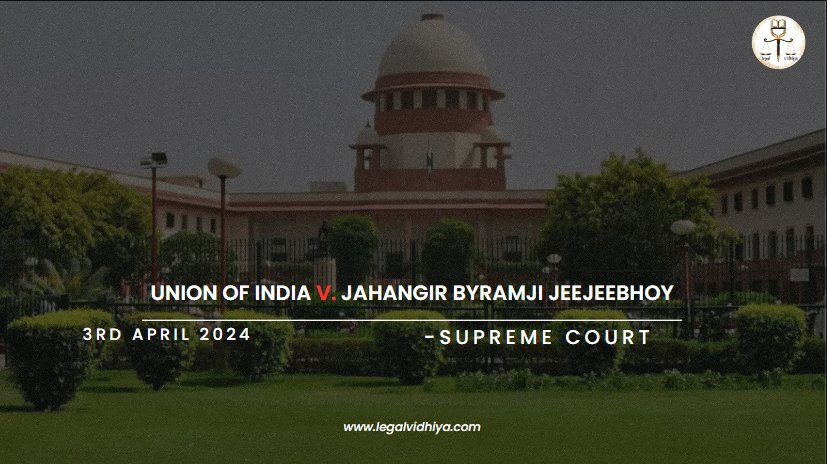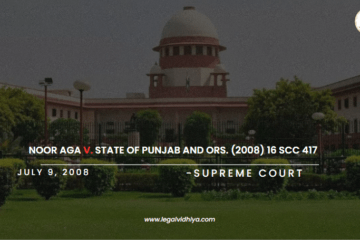
| CITATION | 2024 INSC 262 |
| DATE OF THE JUDGMENT | 3RD APRIL 2024 |
| COURT | SUPREME COURT OF INDIA |
| PETITIONER | UNION OF INDIA |
| RESPONDENT | JAHANGIR BYRAMJI JEEJEEBHOY |
| BENCH | J.B. PARDIWALA, ANIRUDHA BOSE |
INTRODUCTION
The Bombay High Court declined to grant an exemption for the twelve-year and 158 days postponement in submitting the 1993 writ petition restoration plea, which was dismissed in 2006 due to non-prosecution. Presently, the appellants are in front of this court with their appeal.
FACT OF THE CASE
- The suit property was leased by the respondent in favour of the appellants on 09.03.1951 As the date of filing of the suit Appellants committed breach of the terms of the lease deed, the respondent herein instituted civil suit 1981 before the Court of the 4th Additional Small Causes Judge.
- Ordered to pay future mesne profits to the defendant at the amount of Rs. 316 per month.
- Ordered the defendant to reimburse the plaintiffs for their legal expenses.
- Appellants challenged the judgment and decree by filing Civil Appeal No. 850 of 1987.
- The appeal was dismissed by the 8th Additional District Judge, Pune on 29.08.1992.
- Appellants filed Petition No. 2307 of 1993 before the High Court of Bombay under Article 227 of the Constitution of India.
- High Court declined to condone the delay of 12 years and 158 days in filing the restoration application on 09.07.2019.
- On 02.05.1987, Civil suit No 2599 of 1981 was allowed, granting possession of the suit property to the appellants.
- The appellants were directed to deliver vacant possession by 30.6.1987 and pay Rs. 17,383/- to the plaintiffs as damages.
- The Executing Court provided notice to the appellants on March 18, 2016, regarding the execution procedures.
- On 20.08.2018, the appellants filed an application to set aside the order passed by the Executing Court.
- On 26.11.2013, the respondent filed Execution Petition No 16 of 2014.
- On 10.10.2006, Petition No 2307 of 1993 was dismissed for non-prosecution.
ISSUE RAISED
- The inquiry that has to be addressed is whether the High Court erred in issuing the impugned decree?
- The more than 12 years delay in restoration can be permissible or not?
CONTENTIONS OF APPELANT
- The Attorney General of India, Mr. R. Venkataramani, argued on behalf of the appellants that he had a strong case on its own and that the 12-year, 158-day delay should be condoned.
- The learned Attorney General focused a lot of attention on the fact that the respondent herein possessed the suit property on an ancient grant lease and that it is located within the Pune cantonment, which is owned by the Union of India.
- The learned Attorney General asserts that even while the respondent acknowledged that he owned just the super structure and that the land belonged to the Government, he should not be allowed to deny the Government its property in his capacity as a private party.
CONTENTION OF RESPONDENT
- On the other hand, the respondent’s learned senior counsel, Mr. Sudhanshu Chaudhari, fiercely opposed the current appeal and argued that the High Court did not make any mistakes in issuing the contested ruling, let alone legal errors.
- In his argument, he said that the appellants had not provided a strong enough case to justify such a lengthy and excessive wait of more than 12 years in filing the restoration application.
- In the conditions above, the experienced counsel urged that the current appeal be rejected since it lacks merit worthy of consideration.
JUDGMENT
Considering those above, we have concluded that the High Court did not make any mistakes, much less legal errors, when it issued the contested ruling. In this case, the High Court was carrying out its supervisory authority mention under Article 227 of the Indian Constitution.
Numerous rulings from this Court have stated that being generous should not be the reason for a delay. To render significant justice is not to incite animosity toward the other party. This crucial requirement for accepting the delay is not met in this instance as the appellants have not demonstrated that they were fairly diligent in their prosecution of the case.
ANALYSIS
If the respondent handed over the suit property then, the appellants appear to have received a reasonable recommendation from the High Court that the Court would consider reopening Petition No. 2307 of 1993, which was dismissed on October 10, 2006. The appellants’ learned counsel refused to give the respondent herein possession of the suit property, as the High Court previously recognized. Even though there has been a protracted and excessive delay, we may consider condoning the same and remanding the matter back to the High Court so that the High Court may be in a place to hear the matter on its own caliber. This is the exact same suggestion that we made to the learned Attorney General. But after listening to his clients’ instructions, the experienced attorney general expressed remorse for his failure to convince the nine appellants to give the respondent control of the suit property.
The Attorney General was left with little choice but to submit arguments to the court explaining why the case should be considered solely on its merits and why the 12-year, 158-day delay was acceptable. It hardly matters whether the party is a private or union of India when the gross delay is more than 12 years.
The parties to this lawsuit began their legal battle at some point in 1981. It is 2024.
It’s been almost forty-three years. But the respondent hasn’t been allowed to enjoy the benefits of his decree as of yet. To accept the respondent’s 12-year and 158-day delay and expect them to go through the ordeal of the legal proceedings once more would be a mockery of justice.
We believe that the issue of limitation goes beyond simple technological considerations. The concepts of equality and good public policy serve as the foundation for the limitations laws. We shouldn’t hold the “Sword of Damocles” over the respondent’s head for an indeterminate amount of time, subject to the whims and fancies of the appellants.
CONCLUSION
The question before the Supreme Court was that the plea of restoration which has lapse the time limit of 12 years can be admissible, the Supreme Court upheld the High Court judgment said that the petition is not admissible in court of law.
REFRENCES
- https://newslaw.in/case-type/civil/analysis-of-the-supreme-court-judgment-in-union-of-india-anr-vs-jahangir-byramji-jeejeebhoy-a-case-of-delayed-justice/
- https://main.sci.gov.in/supremecourt/2019/27619/27619_2019_5_1501_52030_Judgement_03-Apr-2024.pdf
This article is written by Arsalan Azmi student of Asain Law College, Noida : intern at Legal Vidhiya.
Disclaimer: The materials provided herein are intended solely for informational purposes. Accessing or using the site or the materials does not establish an attorney-client relationship. The information presented on this site is not to be construed as legal or professional advice, and it should not be relied upon for such purposes or used as a substitute for advice from a licensed attorney in your state. Additionally, the viewpoint presented by the author is of a personal nature.




0 Comments